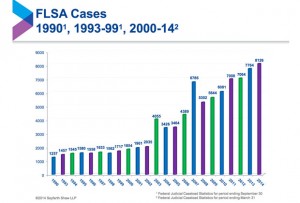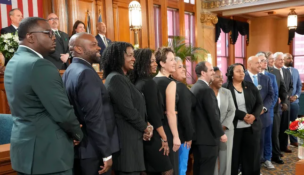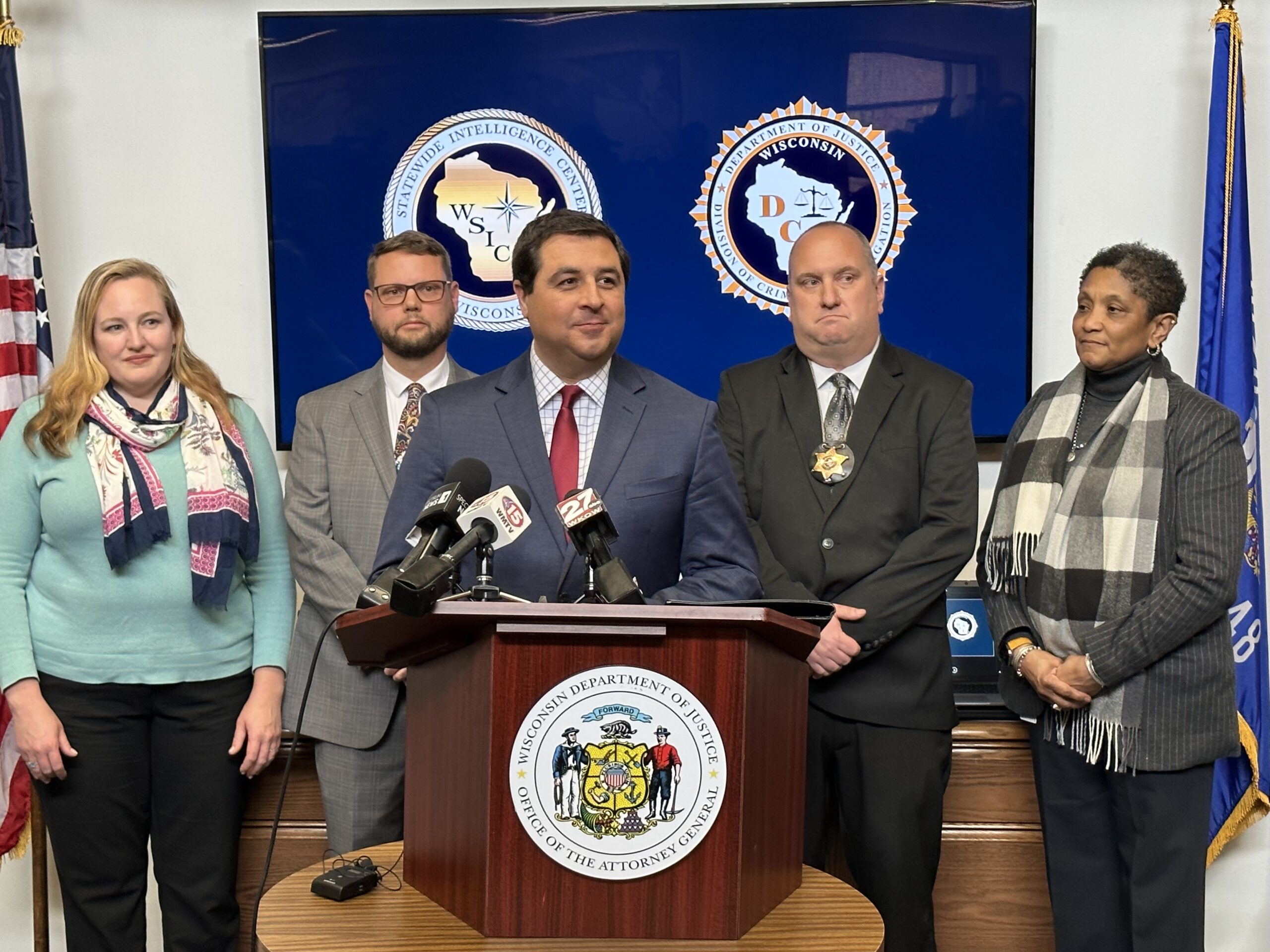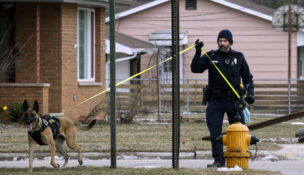Spikes seen in wage, hour lawsuits in Wis., nationwide
By: Eric Heisig//June 9, 2014//
 Federal wage and hour lawsuits have been on the upswing in Wisconsin and nationally for several years, aided in part by increased public awareness, union changes and the ease of which cases are proven.
Federal wage and hour lawsuits have been on the upswing in Wisconsin and nationally for several years, aided in part by increased public awareness, union changes and the ease of which cases are proven.
A study released last month by Chicago law firm Seyfarth Shaw LLP – which regularly represents employers in labor and employment law claims – reported that wage and hour lawsuits brought in federal court have increased significantly in the past 15 years.
Between April 1, 2013 and March 31 there were 8,126 lawsuits filed, according to data the firm obtained from the Federal Judicial Center. That compares to 1,257 suits filed in 1990; a 546 percent increase.
Though there was some fluctuation in that time, the most recent upswing started in 2009, according to the study.
The number of suits and the increase would be even greater if lawsuits considered included those filed in state court over pay practices, tip laws, meal and rest break requirements, independent contractor rules and other factors.
And while Wisconsin’s numbers have fluctuated more than the nation as a whole, the trend here seems to point upward, as well. In 2000, there were six wage and hour lawsuits filed in the state’s federal courts. In 2013, there were 53, and 2014 has seen 20 so far.
The reason for the increase depends on who you ask.
According to Seyfarth Shaw’s study, the federal upswing is partially attributed to ambiguities in the decades-old Fair Labor Standards Act as well as President Barack Obama directing Secretary of Labor Thomas Perez to revise “white collar” regulation exemptions. According to the firm, the last time the exemptions were amended “caused employees to pay more attention to wage and hour policies and practices.”
Richard Alfred, chair of Seyfarth Shaw’s national wage and hour litigation practice group, who worked on the study, also said higher unemployment levels generally result in more claims brought.
“The unemployed are more likely to be unhappy about their circumstances and be more open to the possibility to these legal claims,” Alfred said.
Sean Scullen, a partner with Quarles & Brady LLP, Milwaukee, which also represents employers, pointed to aggressive litigation tactics on the part of labor and employment attorneys. Firms often will cater directly to employees of large companies, he said, or place billboards near a factory or company’s headquarters.
He also pointed to the Fair Labor Standards Act as a reason, explaining that the law often can be too complex for employers to parse through.
“We’re talking about Depression-era legislative practices,” Scullen said, “that have arisen from what employer and employee have worked out as the best arrangement.”

For attorneys who represent laborers, though, the reason for the increase seems to be a bit more clear-cut: declines in union membership.
Paul Secunda, a professor at Marquette University Law School focused on labor and employment law, said membership declines in Wisconsin and nationwide have caused an upswing in litigation.
“Individuals are no longer able to use the arbitration mechanism that unions provide to discuss issues with their employer,” Secunda said. “More often nowadays, they are turning to litigation.”
He said this is seen in the both public and private sector. And in Wisconsin, where Act 10 did away with most collective bargaining rights for the majority of public sector unions, that further contributed to the litigation increase.
If there were more unions, Secunda said, “a lot of this extensive litigation where employers are getting killed would go away.”
Nola Hitchcock Cross, an attorney with Cross Law Firm SC, Milwaukee, said many of the claims made by individuals previously were hammered out during collective bargaining.
The increase also may be because these claims are easy to prove. Secunda said while the law may trip up employers, it can be a lucrative business for attorneys. It’s “not difficult to show” a violation, he said, especially if it boils down to an attorney’s classification and whether he or she is entitled to overtime.
“It’s like shooting fish in a barrel,” Secunda said. “There’s no defense to them when they’re uncovered. It’s a fairly straightforward formula.”
Bill Parsons, an attorney with the Madison office of Hawks Quindel, SC, Milwaukee, said that unlike a discrimination case, where cases rely on a lot of he-said, she-said testimony, wage and hour suits often rely on the law and what the clear-cut facts show.
And Jason Knutson, an attorney at Habush Habush & Rottier SC, Madison, said the expansion of social media has helped those with claims learn about their rights. Seyfarth Shaw lists discussions about minimum wage and “public recognition of successful actions that deal with unpaid wages” as reasons for the uptick.
“Employees are more knowledgeable,” Knutson said. “The Department of Labor is more active and is definitely making the public aware of these violations. Individuals have realized that the class action mechanism is really one of the only ways they can bring these cases when there is a relatively small amount of potential recovery.” Follow @eheisigWLJ
Legal News
- Milwaukee’s Common Council now has the most African Americans, women and openly LGBTQ members ever
- Office of School Safety Provides Behavioral and Threat Assessment Management Training Ahead of 25th Anniversary of Columbine Shooting
- Wisconsin Supreme Court to hear arguments in Democratic governor’s suit against GOP-led Legislature
- Lawsuit asks Wisconsin Supreme Court to strike down governor’s 400-year veto
- Wisconsin man pleads not guilty to neglect in disappearance of boy
- ACS Selects University of Wisconsin Law School’s Miriam Seifter for 2024 Ruth Bader Ginsburg Scholar Award
- People with disabilities sue in Wisconsin over lack of electronic absentee ballots
- Wisconsin Republicans ignore governor’s call to spend $125M to combat ‘forever chemicals’
- Native American voices are finally factoring into energy projects
- Steven Avery prosecutor Ken Kratz admits ‘mistakes were made’
- Colombian national extradited to Milwaukee faces International narcotics-trafficking conspiracy charge
- MPD: Milwaukee homicides down nearly 40 percent compared to last year
WLJ People
- Power 30 Personal Injury Attorneys – Russell Nicolet
- Power 30 Personal Injury Attorneys – Benjamin Nicolet
- Power 30 Personal Injury Attorneys – Dustin T. Woehl
- Power 30 Personal Injury Attorneys – Katherine Metzger
- Power 30 Personal Injury Attorneys – Joseph Ryan
- Power 30 Personal Injury Attorneys – James M. Ryan
- Power 30 Personal Injury Attorneys – Dana Wachs
- Power 30 Personal Injury Attorneys – Mark L. Thomsen
- Power 30 Personal Injury Attorneys – Matthew Lein
- Power 30 Personal Injury Attorneys – Jeffrey A. Pitman
- Power 30 Personal Injury Attorneys – William Pemberton
- Power 30 Personal Injury Attorneys – Howard S. Sicula











